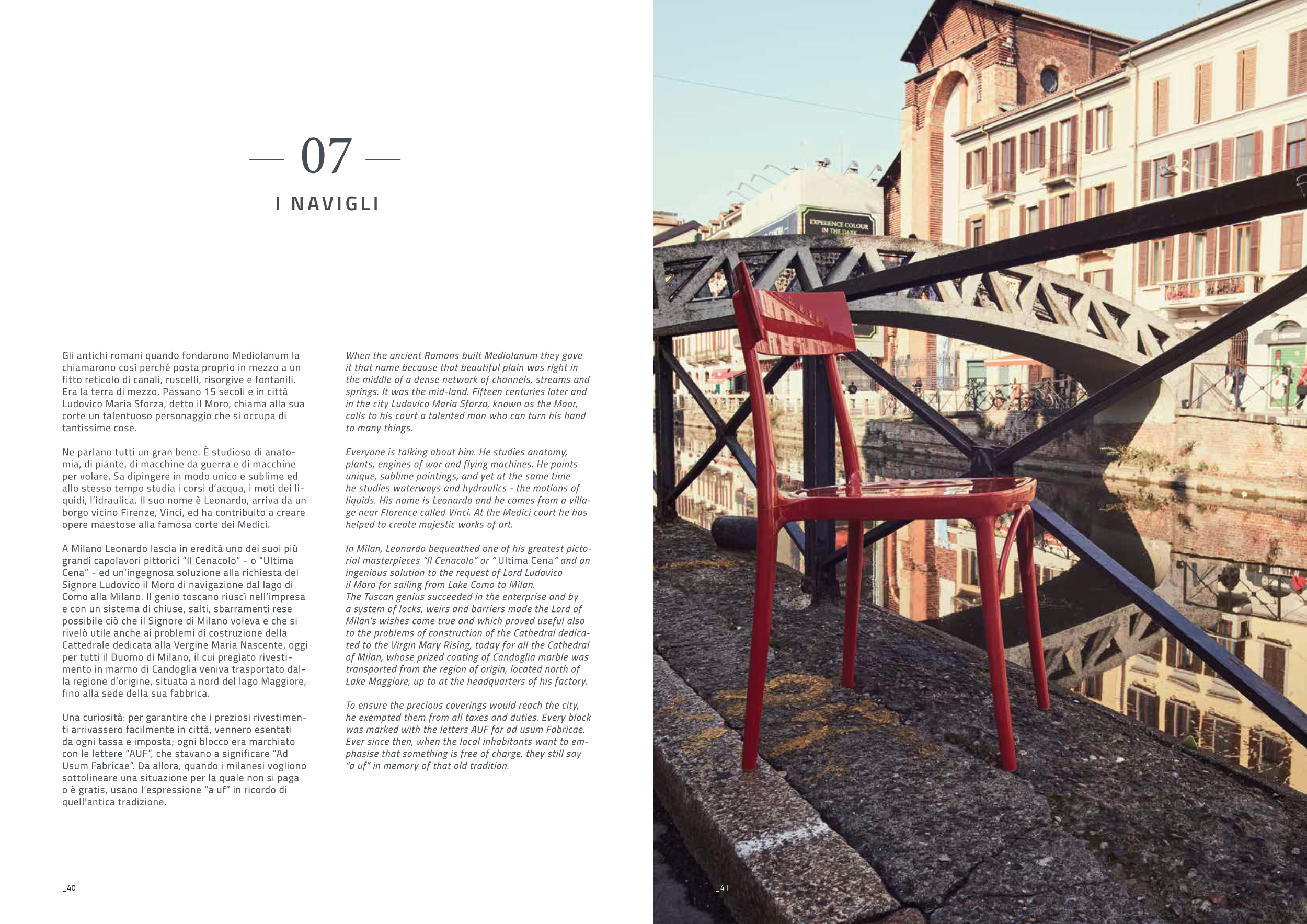07
I N av I G L I
Gli antichi romani quando fondarono Mediolanum la
chiamarono così perché posta proprio in mezzo a un
fitto reticolo di canali, ruscelli, risorgive e fontanili.
era la terra di mezzo. Passano 15 secoli e in città
Ludovico Maria Sforza, detto il Moro, chiama alla sua
corte un talentuoso personaggio che si occupa di
tantissime cose.
Ne parlano tutti un gran bene. È studioso di anato-
mia, di piante, di macchine da guerra e di macchine
per volare. Sa dipingere in modo unico e sublime ed
allo stesso tempo studia i corsi d’acqua, i moti dei li-
quidi, l’idraulica. Il suo nome è Leonardo, arriva da un
borgo vicino Firenze, Vinci, ed ha contribuito a creare
opere maestose alla famosa corte dei Medici.
A Milano Leonardo lascia in eredità uno dei suoi più
grandi capolavori pittorici “Il Cenacolo” - o “Ultima
Cena” - ed un’ingegnosa soluzione alla richiesta del
Signore Ludovico il Moro di navigazione dal lago di
Como alla Milano. Il genio toscano riuscì nell’impresa
e con un sistema di chiuse, salti, sbarramenti rese
possibile ciò che il Signore di Milano voleva e che si
rivelò utile anche ai problemi di costruzione della
Cattedrale dedicata alla Vergine Maria Nascente, oggi
per tutti il Duomo di Milano, il cui pregiato rivesti-
mento in marmo di Candoglia veniva trasportato dal-
la regione d’origine, situata a nord del lago Maggiore,
fino alla sede della sua fabbrica.
Una curiosità: per garantire che i preziosi rivestimen-
ti arrivassero facilmente in città, vennero esentati
da ogni tassa e imposta; ogni blocco era marchiato
con le lettere “AUF”, che stavano a significare “Ad
Usum Fabricae”. Da allora, quando i milanesi vogliono
sottolineare una situazione per la quale non si paga
o è gratis, usano l’espressione “a uf” in ricordo di
quell’antica tradizione.
When the ancient romans built Mediolanum they gave
it that name because that beautiful plain was right in
the middle of a dense network of channels, streams and
springs. It was the mid-land. Fifteen centuries later and
in the city Ludovico Maria Sforza, known as the Moor,
calls to his court a talented man who can turn his hand
to many things.
Everyone is talking about him. He studies anatomy,
plants, engines of war and flying machines. He paints
unique, sublime paintings, and yet at the same time
he studies waterways and hydraulics - the motions of
liquids. His name is Leonardo and he comes from a villa-
ge near Florence called Vinci. At the Medici court he has
helped to create majestic works of art.
In Milan, Leonardo bequeathed one of his greatest picto-
rial masterpieces “Il Cenacolo” or “ Ultima Cena” and an
ingenious solution to the request of Lord Ludovico
il Moro for sailing from Lake Como to Milan.
The Tuscan genius succeeded in the enterprise and by
a system of locks, weirs and barriers made the Lord of
Milan’s wishes come true and which proved useful also
to the problems of construction of the Cathedral dedica-
ted to the Virgin Mary rising, today for all the Cathedral
of Milan, whose prized coating of Candoglia marble was
transported from the region of origin, located north of
Lake Maggiore, up to at the headquarters of his factory.
To ensure the precious coverings would reach the city,
he exempted them from all taxes and duties. Every block
was marked with the letters AUF for ad usum Fabricae.
Ever since then, when the local inhabitants want to em-
phasise that something is free of charge, they still say
“a uf” in memory of that old tradition.
_41
_40


